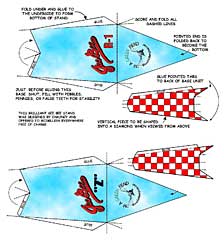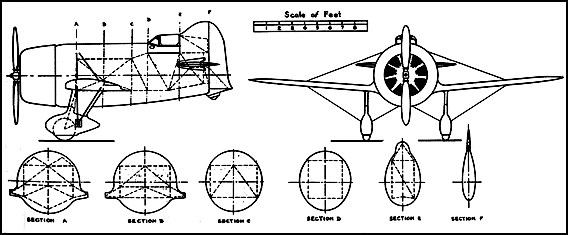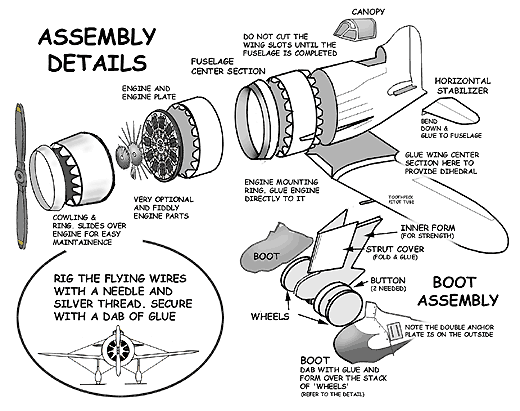


Gee Bee R1 Racer - $$5.95
The Gee Bee Model R Super Sportster (also known as the GB Sportster), sometimes nicknamed The Flying Silo due to the short, fat fuselage resembling that type of farm storage building, was a special purpose racing aircraft made by Granville Brothers Aircraft of Springfield, Massachusetts.
The Granville 1930s Racer Gee Bee R-2
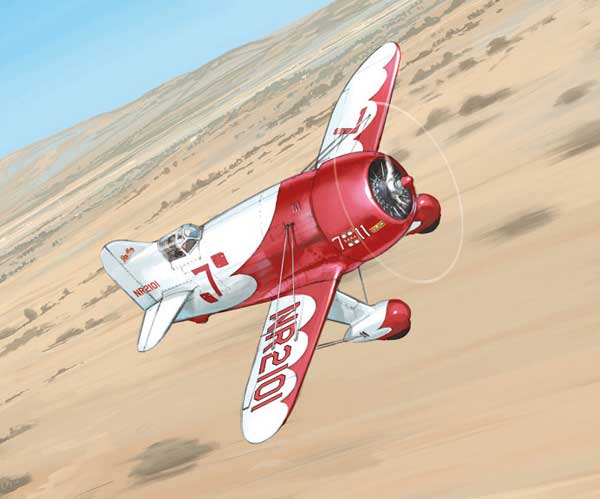
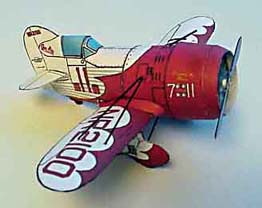
The five Granville Brothers of Springfield, Massachusetts, became famous with their high-powered Gee Bee racing planes of the 1920s and 30s. The planes themselves became notorious for crashing, and some developed a reputation as being 'unflyable'. The Model Z won several races, but during a record attempt a wing folded up on one Model Z and it crashed fatally.
The barrel-like R-1 and R-2 were essentially the largest available engine with the smallest possible airframes behind them. Someone said a Gee Bee was 'a section of sewer pipe which had sprouted stubby wings'. In general the Gee Bees were shorter than their wingspans, made very fast landings and were extremely tricky for all but the most experienced pilots to fly. The Model Rs suffered several crashes. The R-2 killed its pilot and was rebuilt and crashed again not once but twice. Combined with parts of the R-1, the hybrid aircraft crashed fatally on its first test flight.
The Gee Bees really took the fancy of the hundreds of thousands of aviation enthusiasts who flocked to the air races in the 1930s. They were the ideal competition aircraft for these venues, and part of their public appeal was that they were tricky and demanding to fly, earning themselves a reputation of being mean aeroplanes that needed to have a skilled and daring pilot to coax the best out of them.
What super bowl??? ...I was working on a Gee Bee!..That chauncy guy sure is doing some cool stuff!...give him a pat on the back for me...Thanks John
Just finished building the FG Gee Bee R1. It's a kick and great looking when finished. Tried rigging support wires for the first time. I think in the future I'll poke the holes first. Trying to get the needle through the three layers of card in the landing gear I actually put the eye of the needle in my thumb (Deep in my thumb). I also believe I'll try rigging after I've sprayed the model with polyurethane next time as I had to re tighten all the riggings that that expanded when wet. Dan S
When I built the FG Gee Bee Z, I pre-poked the holes, but ditched the thread and used segments of rigid steel craft wire instead. I cut the wire into lengths slightly longer than each segment (i.e. from fuselage to top of wing or from bottom of wing to landing gear spat, etc.) and then anchored the ends of the wires into the pre-punched holes with tacky
glue. I also used pliers to put a slight crook into the ends of the wire segments that helps hold them in place until the glue sets up. I'm MUCH happier with the results, no sagging and the natural finish of the wire just looks great to me. Besides that... it was just plain fun to do it this way. That needle and thread deal just was not my idea of a good time. I'll bet it's not yours either. hehehe Tim R
I ordered the FG Aircraft CD just before Christmas and decided to build the Gee Bee R-1 as my first commercial AC model. It's a little jewel when completed and the wire rigging really makes it look great. I rigged mine by using a beading needle and Coats-and-Clark silver thread. Beading needles are available at just about any craft store and have the advantage of being much longer and of a smaller diameter than most sewing needles.
I also pre-drilled the holes using a pin vise, but I used an old jeweler's trick to make the "drill bit" so I could get very small holes, my #80 drill bit having been "misplaced" long ago. Take an ordinary sewing needle (don't use straight/quilting/sewing pins unless they're made of steel) and carefully hone three flats at the tip. The resulting pyramid shape on the tip of the needle gives it just enough "bite" that it serves very well as drill for soft materials, even brass and aluminum. Since the tips of needles are tapered, you can drill a very small hole. Tim H
I found your web site while looking up my grandfather on the web. He was Edmund Fischer, manager of the Springfield, Ma airport many years ago. I always read any articles on any one whom he might have known. Your article on the Granville Brothers was one of the most informative I have read in a long time. Thank you, Patricia Bouthellier.
The Gee Bee R1 Racer:
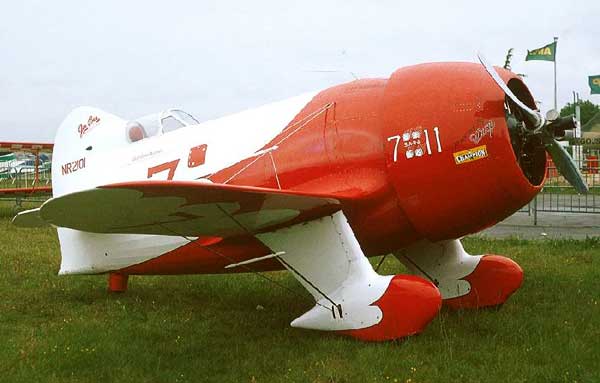
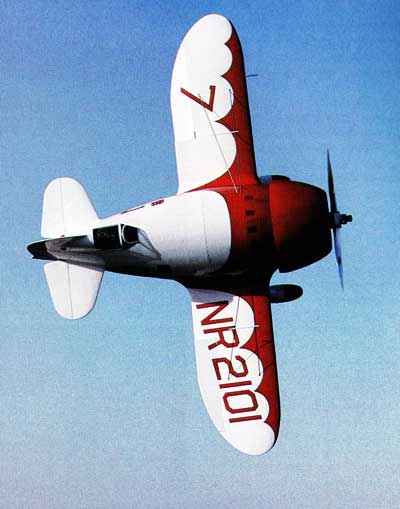 The Granvilles simply streamlined a Pratt and Whitney Wasp Sr engine
and added just enough wing and tail control surface area to barely
keep it airborne and moving at a record speed of almost 300 mph.
All this in 1932.
The Granvilles simply streamlined a Pratt and Whitney Wasp Sr engine
and added just enough wing and tail control surface area to barely
keep it airborne and moving at a record speed of almost 300 mph.
All this in 1932.
With the success of the Model X under their belts, the Granville brothers set out to produce and market a new line of aircraft in the Sportster series. They were billed as "The fastest and most maneuverable licensed airplane for its horsepower in the United States" - and they were all that and more. The Gee Bee Sportsters were frequently shown off at air shows by their owners, attracting much attention wherever they appeared. The prototype models for the D and E were retained by the Granville brothers for a time, and were very successful in production class racing.
The Model Y, known as the Senior Sportster (a two seat version) was also very successful in competition - said to have won more money and races than the purpose built, better known Gee Bee's. However, the marketing of these aircraft could not have happened at a worse time. The Great Depression was entering its dismal peak and the sales of personal aircraft were almost non-existent. There were only a handful of these aircraft ever produced; Only two Model X's, one Model C (later converted to a Model D), one other Model D, four Model E's and two Model Y's.
With the Great Depression taking its toll on sales, the only true venue of hope left to the Granville brothers was racing. An amazingly large sum of prize money was being offered at the Cleveland National Air Races and the Granvilles were convinced to build a racer that could win the Thompson Trophy Race. The Gee Bee Model Z was created - and in 1931 won the Thompson Trophy race in Cleveland, Ohio, showing the world that the Granville Brothers could build the fastest airplanes in America. That same year, during a speed dash attempt, the Model Z shed a wing and rolled into the ground, killing pilot Lowell Bayles. This was the beginning of a run of bad luck that would plague the Granville's racing aircraft.
With the 1932 races just a half year away, Granville Brothers Aircraft hired a new engineer, Howell W. "Pete" Miller, a performance specialist fresh out of school and brimming with innovative ideas. Led by the elder Granville Brother, Zantford"Granny" Granville, the four brothers and Miller set out to build two new planes for the upcoming races. The racers would be designated the Model R-1 and R-2 and powered by engines on loan from Pratt & Whitney. The R-1 was designed and built around the new R-1340 ci nine-cylinder, supercharged engine which produced 800 hp. Built for the Thompson Trophy race, a pylon course, it would be a short-range airplane built for all-out speed. The R-2, on the other hand,was built for the Bendix Trophy race,where long-range and speed were needed. Consequently, the R-2 was powered by the R-985ci Pratt & Whitney engine developing 535 hp. Burning less fuel than its bigger brother, the R-2 could fly the race with fewer stops, giving it a better overall speed. The main difference between the two airplanes, other than engines, was that the R-2 held 302 gallons of fuel versus the 160 gallons of the R-1. There were other slight differences as well, such as the shapes of the vertical fin rudder, and the R-2's fixed tail wheel versus the R-1's steerable tail wheel.
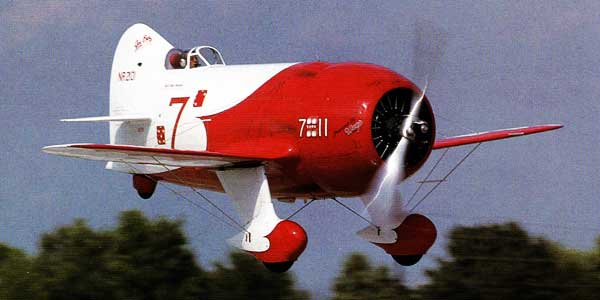
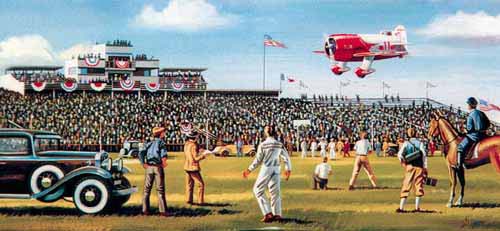
In the hands of Jimmy Doolittle, the R-1 won the 1932 Thompson
Trophy race.
At that time Doolittle also set a new world land plane speed record
of 296 mph in the Shell Speed Dash, a straight line course. Lee
Gehlbach, flying the R-2, finished fourth in the Bendix due to
oil leak problems and fifth in the Thompson. Once again, the Granville
Brothers brought home the trophies. They were on top of the world.
Then in 1933, in the hands of pilot Russel Thaw, the R-2 stalled
on landing approach at Indianapolis, rolled, and hit the wingtip.
Although he recovered with only wing and landing gear damage,
the R-2 was out of that race. Russ Boardman, pilot of the R-1,
was shaken by Thaw's accident and, pulling the R-1 off prematurely,
stalled and caught a wingtip, flipping the plane onto its back.
Boardman died from the injuries. The R-2 was repaired and while
landing at Springfield in 1933, James Haizlip found himself floating
too far down the 2,000 ft runway. As was done with most airplanes
of that period, he kicked the rudder to sideslip and kill the
speed. This caused one wing to stall, and once again the R-2 found
itself rolled into a ball. Haizlip escaped without serious injuries,
barring his pride.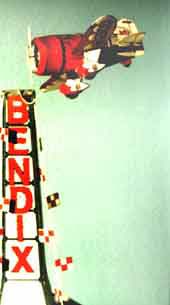
Granville Brothers Aircraft used parts from both crashed airplanes to build the R-1/R-2, a hybrid model initially flown by Roy Minor. During a test flight out of Springfield, he made thirteen landing attempts before finally getting it on the deck; whereupon he slid off the end of the runway with the brakes locked. The airplane caught its wheels in a ditch, performed a complete somersault, and landed upright on the road. After another trip through the shop, the R-1/R-2 ended up with Cecil Allen. Despite warnings from Miller and Zantford Granville, Allen Granville installed a large fuel tank well aft of the center of gravity (cg). The two designers feared the cg would be moved so far back that the plane would be impossible to fly. Ignoring their warnings, Allen took off with the tank full, lost control, crashed, and was killed. Thus ended the R-1 and R-2 racers, as well as the Gee Bee line of aircraft.
The Granville Brothers Aircraft, Inc., liquidated in the fall of 1933. They built a total of 22 aircraft - including 9 biplanes, 8 Sportsters, 2 Senior Sportsters, 3 Super Sportsters, and one long-tailed racer. They had a large, cantilever monoplane under construction that disappeared into history. After liquidation, the workforce went on to build the QED for the 1934 England-to-Australia race and Time Flies, a racer for Frank Hawks.
Even though none of the original Gee Bee Sportster Series aircraft survive today, they were without doubt some of the most unique and beautiful aircraft ever to grace the skies.
Jimmy Doolittle and the Gee Bee Racer
One of America's greatest military airmen and a leading figure in the pantheon of aviation, Jimmy Doolittle joined the U.S. Army Air Service during World War I Although he served as a flight and gunnery instructor, he never got into action.
In 1929, he led the effort to develop blind-flying instruments. In the early days of flying, pilots were at considerable risk from bad weather and fogged-in runways. Doolittle became the first pilot to take off, maneuver for 15 miles, and land safely, relying only on the aircraft instruments rather than looking outside his aircraft.
In 1931, Jimmy Doolittle won the Bendix transcontinental air race with a time of 11 hours 16 minutes and an average speed of 223 miles per hour. The following year, he flew the Granville Gee Bee race plane with a world record speed of 294 miles per hour and won the Thompson Trophy. Doolittle and Roscoe Turner were the only pilots to win both the Bendix and Thompson trophies.
He returned to active duty during World War II, and in 1942,he organized what would be his most famous achievement. Lieutenant Colonel Doolittle established a seemingly impossible air raid on Tokyo, using USAAF B-25 medium bombers launched from a U.S. Navy aircraft carrier. On April 18, 1942, all 16 planes of Doolittle's strike force successfully took off from the USS Hornet. While the physical damage to Japan was negligible, the mission boosted the American morale.
All of Doolittle's crews, except one, safely reached China. Doolittle was awarded the Medal of Honor. Promoted to brigadier general, he went on to command the 12th and 15th U.S. Army Air Forces. As a lieutenant general, he commanded the USAAF 8th Air Force for the last 18 months of the war.
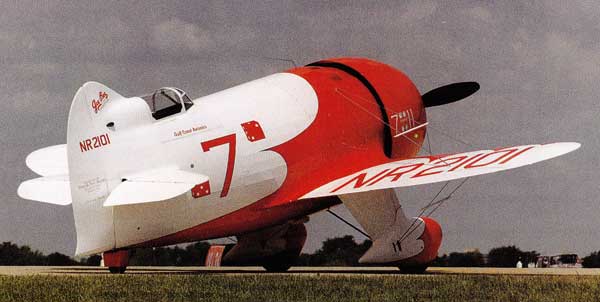
Doc Rowland. not MD -but PH....writes about what he did when it came to making the Gee Bee R-1 wheel parts....
...the following method works out better. Cut a 3/8" circle of 1/16 balsa and glue this between the halves of the stiffeners, following the outline of the tire printing. Dampen paper slightly, and work the stiffener around the balsa, coaxing gently into shape. Make sure tire printing is facing OUTWARDS! Then, glue the halves of the pant onto the WHEEL PART ONLY! Cut the upper landing gear fairing in half, and insert each half between the pant and the stiffener, match the profile with the stiffener and glue. There should be a slight overlap at the leading and trailing edges. Then, work around the edges, carefully gluing all easily opposable margins. NOW, here comes the fiddly part. There will be gaps at the upper and lower margins of the pant halves, as well as the trailing edges. Take a small strip of paper and glue this over the gaps using the trusty "TLAR" method. Use your Iris or Castroviejo scissors to trim the pieces flush, and paint to match. Works beautifully!
Some Free Fun Stuff
Right here with just a click on the image you can download free:
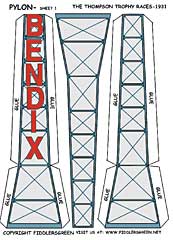 Score Board and Pylon |
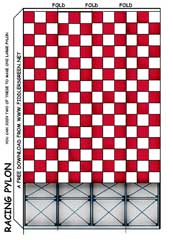 Racing Pylon |
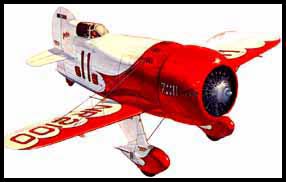 |
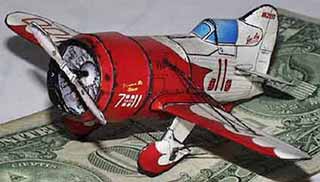 |
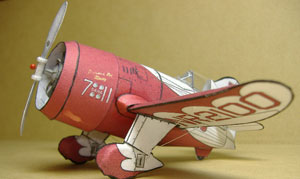 |
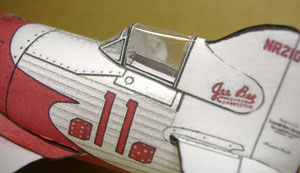 |
Clear Cabin Gee Bee Racer Submitted by Bob Martin. Thanx Bob! |
|
Notes about the wing from
a member of the Modeling Group...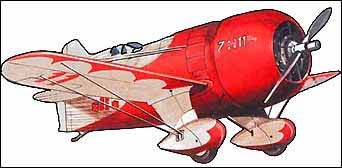
I assembled the body then cut out the wing slots and inserted
the wing. I traced the curve of the wing against a piece of paper
and used that as a guide to draw the outline of the wing slot
cutout on the assembled body tube. I also cut a round former out of cardboard and glued it in
the front of the body tube after I inserted the wing to insure
the body kept the correct shape. Michael C
More...Great ideas on assembly. I hadn't thought of going that way but will give it a try. This is still Gee Bee #1 and I expect that I will have at least one more before I am happy with the results. Have already learned that I can do the wings better the next time by using the rounded back of a small screwdriver on a mouse pad to spoon out the inside of the wing. This way they have the shape they need with no stress on the paper after it is finished. The top will have the airfoil and the bottom will be close to flat....Denis B
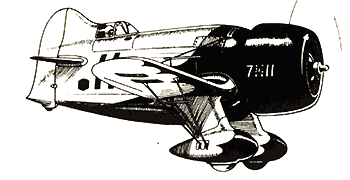
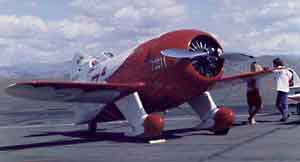
Specifications
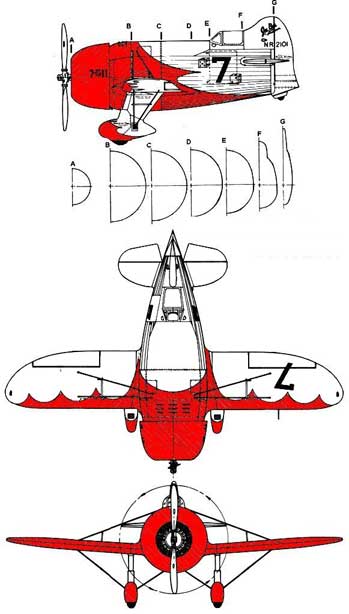 |
Length: 17 ft 8 in Wingspan: 25 ft Height: 8 ft 2 in Wing area: 75 ft² Empty weight: 1840 lbs Loaded weight: 2415 lbs Max takeoff weight: 3075 lbs Powerplant: 1× Pratt & Whitney Wasp 1,344 cuin displacement Air Cooled 9 cylinder radial, 800 hp Aspect ratio: 6.1 , Incidence: 2.5 Degrees Performance Max speed: 294.38 mph Cruise speed: 260 mph Stall speed: 90 mph Range: 925 miles, 630 miles, full throttle Rate of climb: 6100 ft/min (31 m/s Lift-to-drag ratio: 14.6 full throttle: 2.14 hours, cruising: 3.65 hours) |
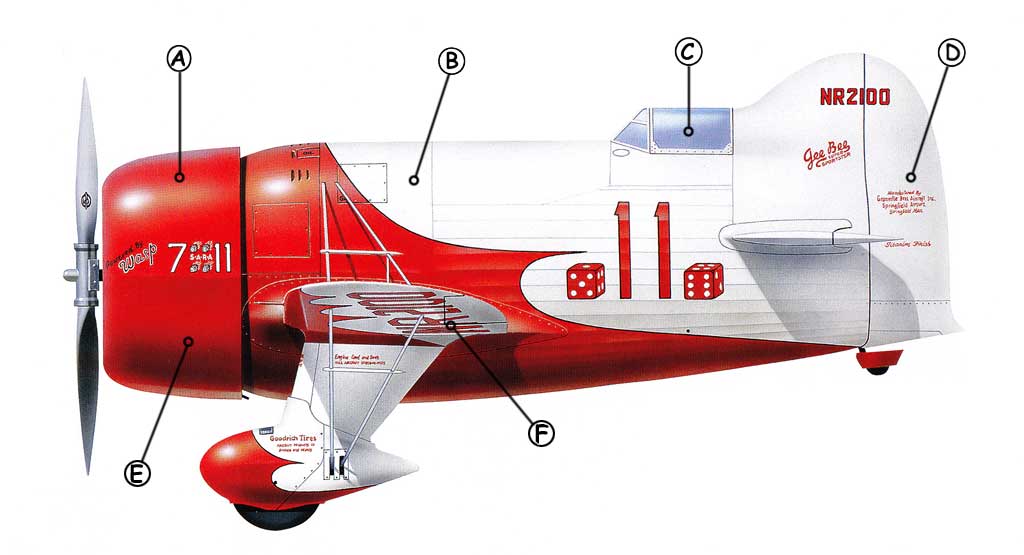 |
||
| A: R-1 and R-2 were designed for minimal frontal area at the expense of almost everything else, including the pilot's visibility. The high speed and no view made landings particularly exciting. | B: The R-1 was a circuit racer and the R-2 had more fuel for cross-country racing. The hybrid aircraft had an additional tank, which moved the center of gravity too far aft. | C: The Gee Bee Racers Canopy was solid and did not allow exit from the craft, the pilot had to get in and out of the aircraft through a small hatch on the starboard side. |
| D: The small rudder on the R-1 & R-2s was just barely enough surface to keep these feisty aircraft under control. | E: The powerful P&W Wasp Engine that the Gee Bee Racers was designed around created tremendous torque that threatened to send the plane out of control. | F: Wing flutter is thought to be behind at least one Gee Bee crash. At racing speeds the structure could resonate and quickly fail. |
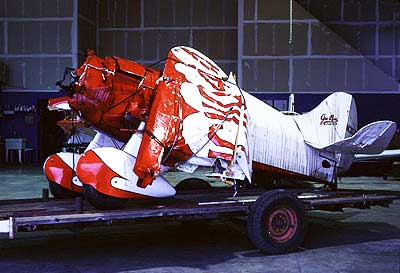 |
On May 23, 1997, Crosby Gee Bee Sportster, N11044 crashed few miles short of runway while approaching Watsonville airport for the airshow.
Luckily the pilot was able to walk away from the crash. |



